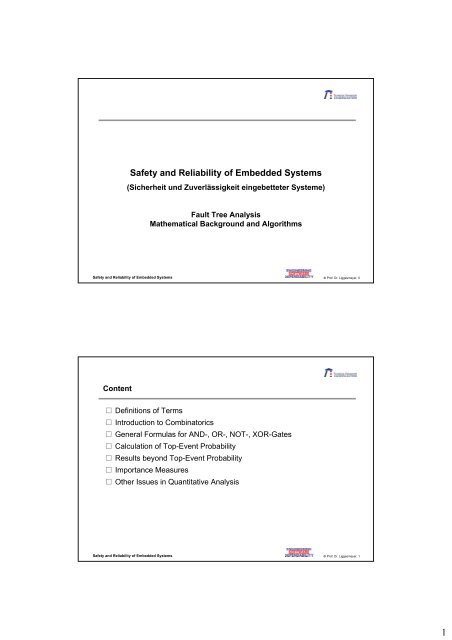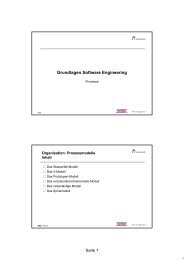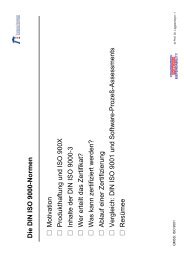Safety and Reliability of Embedded Systems - Software Engineering ...
Safety and Reliability of Embedded Systems - Software Engineering ...
Safety and Reliability of Embedded Systems - Software Engineering ...
Create successful ePaper yourself
Turn your PDF publications into a flip-book with our unique Google optimized e-Paper software.
<strong>Safety</strong> <strong>and</strong> <strong>Reliability</strong> <strong>of</strong> <strong>Embedded</strong> <strong>Systems</strong>(Sicherheit und Zuverlässigkeit eingebetteter Systeme)Fault Tree AnalysisMathematical Background <strong>and</strong> Algorithms<strong>Safety</strong> <strong>and</strong> <strong>Reliability</strong> <strong>of</strong> <strong>Embedded</strong> <strong>Systems</strong>© Pr<strong>of</strong>. Dr. Liggesmeyer, 0Content Definitions <strong>of</strong> Terms Introduction to Combinatorics General Formulas for AND-, OR-, NOT-, XOR-Gates Calculation <strong>of</strong> Top-Event Probability Results beyond Top-Event Probability Importance Measures Other Issues in Quantitative Analysis<strong>Safety</strong> <strong>and</strong> <strong>Reliability</strong> <strong>of</strong> <strong>Embedded</strong> <strong>Systems</strong>© Pr<strong>of</strong>. Dr. Liggesmeyer, 11
Definitions <strong>of</strong> Terms Failure is any behavior <strong>of</strong> a component or system that deviates fromthe specification Fault is an abnormal state or condition within a component that canlead to a failure Accident is an undesired event that causes death or injury <strong>of</strong> personsor harm to goods or to the environment Hazard is a state <strong>of</strong> a system <strong>and</strong> its environment where theoccurrence <strong>of</strong> an accident depends only on influences that are notcontrollable by the system Risk is the combination <strong>of</strong> hazard probability <strong>and</strong> severity <strong>of</strong> theresulting accident Acceptable Risk is a level <strong>of</strong> risk that authorities or other bodieshave defined as acceptable according to acceptance criteria<strong>Safety</strong> <strong>and</strong> <strong>Reliability</strong> <strong>of</strong> <strong>Embedded</strong> <strong>Systems</strong>© Pr<strong>of</strong>. Dr. Liggesmeyer, 2Definitions <strong>of</strong> TermsOther definitions exist,but many <strong>of</strong> them are unpractical <strong>Safety</strong> is freedom from unacceptable risks <strong>Safety</strong> analysis aims at proving that the actual risk is below the acceptable risk Availability is the property <strong>of</strong> a system to fulfill its purpose at a givenpoint in time / is the probability that the system fulfills its purpose at agiven point in time The focus is on uninterrupted service <strong>Reliability</strong> is the property <strong>of</strong> an entity to fulfill its reliabilityrequirements during or after a given time span under givenapplication conditions <strong>Reliability</strong> is related to the probability <strong>of</strong> a failure event over the mission time<strong>Safety</strong> <strong>and</strong> <strong>Reliability</strong> <strong>of</strong> <strong>Embedded</strong> <strong>Systems</strong>© Pr<strong>of</strong>. Dr. Liggesmeyer, 32
Modeling <strong>of</strong> <strong>Reliability</strong> <strong>Reliability</strong> Function R(t):• F(t) gives the probability that at time t the (non-repairable) system has failed• Thus R(t) = 1 - F(t) is the probability that at time t no failure has occurred yet Probability Density f(t):• The probability density f(t) describes the modification <strong>of</strong> the probability that a system fails overtime:ƒ(t) = Failure Rate:d F(t)dt• The failure rate is the relative boundary value <strong>of</strong> failed entities at time t in a time interval thatapproximates zero, referring to the entities still functional at the beginning <strong>of</strong> the time interval:ƒ(t) dF(t) / dtλ(t) = = =R(t) R(t)- dR(t) / dtR(t)States have a probability.Events have a probability density<strong>and</strong> an (occurrence) rate<strong>Safety</strong> <strong>and</strong> <strong>Reliability</strong> <strong>of</strong> <strong>Embedded</strong> <strong>Systems</strong>© Pr<strong>of</strong>. Dr. Liggesmeyer, 4Cut Sets, Minimal Cut Sets, Path Sets A Cut Set is a set <strong>of</strong> basic events, which in conjunction cause the topevent A Minimal Cut Set (MCS) is a cut set that no longer is a cut set if any<strong>of</strong> its basic events is removed A Path Set is a set <strong>of</strong> basic events that, if they are false, inhibit thetop event from occurring A Minimal Path Set (MPS) is a path set that no longer is a path set ifany <strong>of</strong> its basic events is removed<strong>Safety</strong> <strong>and</strong> <strong>Reliability</strong> <strong>of</strong> <strong>Embedded</strong> <strong>Systems</strong>© Pr<strong>of</strong>. Dr. Liggesmeyer, 53
Introduction to Combinatorics: Truth ValuesAND: A ∧ BOR: A∨ BProposition A FalseTrueProposition B FalseFalseFalseTrueFalseFalseTrueTrueTrueTrue True <strong>and</strong> False are <strong>of</strong>ten represented by 0 <strong>and</strong> 1 The propositions are usually <strong>of</strong> the type "Component X is in a failed state"<strong>Safety</strong> <strong>and</strong> <strong>Reliability</strong> <strong>of</strong> <strong>Embedded</strong> <strong>Systems</strong>© Pr<strong>of</strong>. Dr. Liggesmeyer, 6Introduction to Combinatorics: ProbabilitiesA is true with probability P1, B with probability P2Proposition A 1-P1P1Proposition B 1-P2(1-P1) * (1-P2)P1 * (1-P2)P2(1–P1) * P2P1 * P2AND:OR:P(A ∧ B)= P1 * P2P(A∨ B) = P1 * (1-P2) + (1–P1) * P2 + P1 * P2= 1- [(1-P1)*(1-P2)]= P1 + P2 – P1*P2<strong>Safety</strong> <strong>and</strong> <strong>Reliability</strong> <strong>of</strong> <strong>Embedded</strong> <strong>Systems</strong>© Pr<strong>of</strong>. Dr. Liggesmeyer, 74
General Formulas for AND / OR with n Inputs, NOT, XORAND-Gate:OR-Gate:n∏P out= P ii=1∏ ( 1 − )P out= 1 − P ini=1Precondition for these formulas:Stochastically independentevents! NOT-Gate: P = 1 − (only one input)outP inXOR-Gate:Pout=n∑i = 1P ⋅in∏j = 1j ≠ i(1 − P )j XOR is normally defined for 2 inputs only The n-out-<strong>of</strong>-m Voter can be replaced by a combination <strong>of</strong> AND / OR gates The Inhibit-Gate can be replaced by an AND <strong>and</strong> a NOT gate The Priority-AND has no static combinatorial formula<strong>Safety</strong> <strong>and</strong> <strong>Reliability</strong> <strong>of</strong> <strong>Embedded</strong> <strong>Systems</strong>© Pr<strong>of</strong>. Dr. Liggesmeyer, 8Calculation <strong>of</strong> Top-Event ProbabilityLaptopunavailable0.154 Apply gate formulas in a bottom-upfashion Stop if top-event is reached>=10.06 Bottom-up calculation is not efficient forlarge FTs&There are two practical algorithms...0.2 0.3 0.1Battery emptyNo socketaroundHardwaredefective<strong>Safety</strong> <strong>and</strong> <strong>Reliability</strong> <strong>of</strong> <strong>Embedded</strong> <strong>Systems</strong>© Pr<strong>of</strong>. Dr. Liggesmeyer, 95
Calculation Method 1: Minimal Cut Sets The top-event is the union <strong>of</strong> all intersection-free minimal cut sets If cut-set probabilities are small (below 0.1), then intersectionprobabilities are even smaller The top-event probability is the sum <strong>of</strong> all MCS probabilities∑P top= P MCSall MCS The probability <strong>of</strong> each MCS is the product <strong>of</strong> the probabilities <strong>of</strong> theincluded basic events∏P MCS= P iall events ∈MCSi This algorithm leads to an approximation. It does not work for NOT gates<strong>Safety</strong> <strong>and</strong> <strong>Reliability</strong> <strong>of</strong> <strong>Embedded</strong> <strong>Systems</strong>© Pr<strong>of</strong>. Dr. Liggesmeyer, 10Finding Minimal Cut Sets Decompose the tree recursively For each OR gate• Generate as many entries as there are inputs {(i1), (i2), (i3)...} For each AND gate• Generate one entry containing all inputs {(i1, i2, i3,...)} Repeat until all gates are resolved Cancel cut sets that are not minimal (redundant)<strong>Safety</strong> <strong>and</strong> <strong>Reliability</strong> <strong>of</strong> <strong>Embedded</strong> <strong>Systems</strong>© Pr<strong>of</strong>. Dr. Liggesmeyer, 116
Calculation Method 2: Using BDDs BDD = Binary Decision Diagram OBDD = Ordered BDD (defined variable order) ROBDD = Reduced Ordered BDD (after elimination <strong>of</strong> redundancies) ROBDDs are an efficient representation <strong>of</strong> Boolean formulasdashed = falsesolid = truef = (x1 ∨ x2) ∧ x3<strong>Safety</strong> <strong>and</strong> <strong>Reliability</strong> <strong>of</strong> <strong>Embedded</strong> <strong>Systems</strong>© Pr<strong>of</strong>. Dr. Liggesmeyer, 12BDD Reduction Removal <strong>of</strong> redundant nodes (terminal <strong>and</strong> non-terminal) <strong>and</strong> tests:<strong>Safety</strong> <strong>and</strong> <strong>Reliability</strong> <strong>of</strong> <strong>Embedded</strong> <strong>Systems</strong>© Pr<strong>of</strong>. Dr. Liggesmeyer, 137
Impact <strong>of</strong> Variable Order The variable order may have considerable influence on the size <strong>of</strong> theOBDDs Same function, different variable order:x 3x 2x 1© Pr<strong>of</strong>. Dr. Liggesmeyer, 150 1 Finding the best variable order is NP-complete (= unachievable for large FTs)<strong>Safety</strong> <strong>and</strong> <strong>Reliability</strong> <strong>of</strong> <strong>Embedded</strong> <strong>Systems</strong>© Pr<strong>of</strong>. Dr. Liggesmeyer, 14Calculation <strong>of</strong> Top-Event Probability via BDDs Annotate probabilities fromFT to true branches0.90.1 Annotate 1-P to falsebranches0.80.70.20.3 For each path multiply branchprobabilities Sum up all paths that lead toterminal 1P = 0.1 * 0.3 + 0.9 * 0.2 * 0.3 = 0,084<strong>Safety</strong> <strong>and</strong> <strong>Reliability</strong> <strong>of</strong> <strong>Embedded</strong> <strong>Systems</strong>8
Results beyond Top-Event Probability Probability <strong>of</strong> cut sets with order 1 (consisting <strong>of</strong> only one event)• Single points <strong>of</strong> failure should have extremely low probability Failure probabilities <strong>of</strong> (technical) sub-systems• Here, redundancy can reduce failure probability <strong>of</strong> the system Equivalent failure rates• Specify, which percentage <strong>of</strong> the intact systems are expected to failwithin a given time span<strong>Safety</strong> <strong>and</strong> <strong>Reliability</strong> <strong>of</strong> <strong>Embedded</strong> <strong>Systems</strong>© Pr<strong>of</strong>. Dr. Liggesmeyer, 16Importance Measures Importance measures quantify the significance <strong>of</strong> FT events in terms<strong>of</strong> their contribution to the top-event probability To know the importance <strong>of</strong> part <strong>of</strong> the FT is important for• Robustness Estimation: How much will my result change if input valuesare roughly estimated or change during operation?• Work planning: You should rather spend your time on system changesthat have significant impact on overall failure probability<strong>Safety</strong> <strong>and</strong> <strong>Reliability</strong> <strong>of</strong> <strong>Embedded</strong> <strong>Systems</strong>© Pr<strong>of</strong>. Dr. Liggesmeyer, 179
Some Importance Measures Fussell-Vesely Importance• Absolute or relative (= percentage) contribution to the top-eventprobability Risk Reduction Worth or Top Decrease Sensitivity• Decrease <strong>of</strong> top-event probability if a given event is assured not to occur Risk Achievement Worth• Increase <strong>of</strong> top-event probability if a given event occurs Binbaum's Importance Measure• Rate <strong>of</strong> change <strong>of</strong> top-event probability in relation to rate <strong>of</strong> change <strong>of</strong> agiven event<strong>Safety</strong> <strong>and</strong> <strong>Reliability</strong> <strong>of</strong> <strong>Embedded</strong> <strong>Systems</strong>© Pr<strong>of</strong>. Dr. Liggesmeyer, 18Other Issues in Quantitative Analysis Uncertainty Quantification• Event data is taken from samples or from other environment• Sensitivity analysis or formal uncertainty analysis (assigning a probabilitydistribution) Coverage Factors• Take into account that some failures do not lead to catastrophic results Time or Phase Dependent Analysis• Use different models or rates for different time intervals according tomission phases<strong>Safety</strong> <strong>and</strong> <strong>Reliability</strong> <strong>of</strong> <strong>Embedded</strong> <strong>Systems</strong>© Pr<strong>of</strong>. Dr. Liggesmeyer, 1910
Literature FTA <strong>and</strong> Probabilistic Risk Assessment• Birolini A., <strong>Reliability</strong> engineering: theory <strong>and</strong> practice (third ed.), New York, Springer, 1999• Kececioglu, D.: <strong>Reliability</strong> <strong>Engineering</strong> H<strong>and</strong>book, Vol. 1 & 2, PTR Prentice Hall, 1991. Minimal Cut Sets• Fussel JB, Vesely WE, A new methodology for obtaining cut sets for fault trees, in Trans.American Nuclear Society, 15, 262, 1972• T. Kohda & EJ Henley, On Digraphs, Fault Trees,<strong>and</strong> Cut Sets, <strong>Reliability</strong> <strong>Engineering</strong> <strong>and</strong>System <strong>Safety</strong>, 20 (1), 1988, p. 35-61 BDD Algorithm• Bryant, R.E.: Graph-based algorithms for boolean function manipulation. IEEE Transactionson Computers, C-35(8):677--691, Aug. 1986.• O. Coudert <strong>and</strong> J. C. Madre. Fault tree analysis: 10^20 prime implicants <strong>and</strong> beyond. InProceedings <strong>of</strong> the Annual <strong>Reliability</strong> <strong>and</strong> Maintainability Symposium, pages 240-5, Atlanta,GA, 26-28 January 1993• A. Rauzy. An Brief Introduction to Binary Decision Diagrams. RAIRO-APII-JESA, 30(8):1033-1051, 1996<strong>Safety</strong> <strong>and</strong> <strong>Reliability</strong> <strong>of</strong> <strong>Embedded</strong> <strong>Systems</strong>© Pr<strong>of</strong>. Dr. Liggesmeyer, 2011






